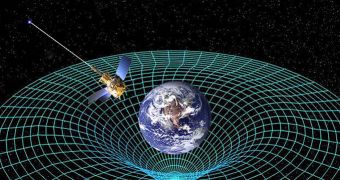When Albert Einstein's theory of general relativity appeared, experts derived a number of predictions from it, and then meticulously began to investigate them. Two such predictions that stem from the theory were finally confirmed by a mission belonging to NASA and the Stanford University.
The project consists of four, extremely-precise gyroscopes housed inside a satellite. The spacecraft revolves in a polar orbit around the planet, and is always aiming at a single point in space, the nearby star IM Pegasi.
This enabled experts to look for slight variations in the satellite's trajectories. According to theory, these disturbances should exist, as they are produced by our planet's gravitational pull. However, no direct experiment testified their existence until now.
NASA and Stanford experts say that the mission, called Gravity Probe B, looked for two things – the geodetic effect and the frame-dragging effect. The former refers to the fact that massive bodies such as planets and stars distort spacetime around them.
The frame-dragging effect is the amount of pull spacetime experiences when it is distorted by a rotating body. It is similar in appearance to the crumples in a bed sheet, that form when you press your finger against it, and then turn.
Gravity Probe B enabled experts to analyze these two effects with unprecedented precision. This was made possible by the gyroscopes on GP-B, whose direction of spin suffered minute changes, according to predictions.
If their spin remained uniform, then this would have been an indication that Einstein's predictions are not correct. Details of the new work appear in the latest online issue of the esteemed scientific journal Physical Review Letters.
“Imagine the Earth as if it were immersed in honey. As the planet rotated its axis and orbited the Sun, the honey around it would warp and swirl, and it's the same with space and time,” Francis Everitt says.
The expert, who is a physicist at Stanford, is the principal investigator for the Gravity Probe B mission.
“GP-B confirmed two of the most profound predictions of Einstein's Universe, having far-reaching implications across astrophysics research,” he goes on to say.
“Likewise, the decades of technological innovation behind the mission will have a lasting legacy on Earth and in space,” the expert adds. This particular mission took a total of 52 years to imagine, plan, develop, put together, launch and conduct, experts at Stanford and NASA say.
“The mission results will have a long-term impact on the work of theoretical physicists for years to come,” explains NASA Headquarters program scientist and senior astrophysicist Bill Danchi.
“Every future challenge to Einstein's theories of general relativity will have to seek more precise measurements than the remarkable work GP-B accomplished,” he concludes.

 14 DAY TRIAL //
14 DAY TRIAL //